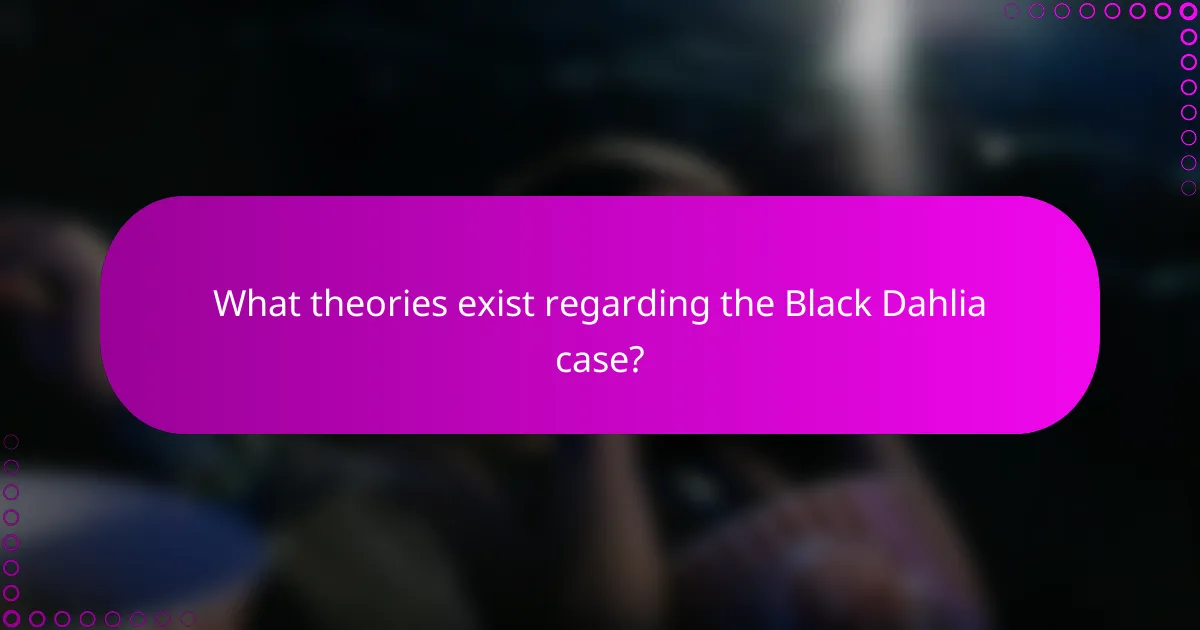The Black Dahlia case refers to the unsolved murder of Elizabeth Short, an American woman whose body was discovered in 1947 in Los Angeles, California. The case is notorious for the brutal mutilation of Short’s body and the extensive media coverage it received, contributing to its place in American crime history and popular culture. Various theories surrounding the case include the possibility of a serial killer, connections to organized crime, involvement of a medical professional, and potential cover-ups by law enforcement. The Black Dahlia case has influenced numerous media portrayals, including films, books, and documentaries, highlighting its lasting impact on public fascination with unsolved murders.

What is the Black Dahlia case?
The Black Dahlia case refers to the unsolved murder of Elizabeth Short in 1947. Elizabeth Short was an American woman who gained posthumous fame as the victim of a gruesome crime. Her body was discovered in a vacant lot in Los Angeles, California. The murder was characterized by the mutilation of her body and the manner in which it was displayed. The case received extensive media coverage, which contributed to its notoriety. Despite numerous investigations and suspects, the case remains officially unsolved. The Black Dahlia case has become a significant part of American crime history and popular culture.
Who was Elizabeth Short, the Black Dahlia?
Elizabeth Short, known as the Black Dahlia, was an American woman whose murder in 1947 gained widespread media attention. She was born on July 29, 1924, in Hyde Park, Massachusetts. Short moved to California in the 1940s, seeking a career in acting. Her body was discovered in a vacant lot in Los Angeles on January 15, 1947. The brutal nature of her murder and the subsequent media coverage led to sensationalism surrounding her case. The nickname “Black Dahlia” was coined by the press, inspired by a film noir and her dark attire. Despite extensive investigations, her murder remains officially unsolved. The case has since become a significant part of American crime lore.
What are the key facts about Elizabeth Short’s life?
Elizabeth Short was an American woman born on July 29, 1924. She is best known as the victim of a highly publicized murder in Los Angeles in 1947. Short was nicknamed the “Black Dahlia” due to her dark clothing and hairstyle. She grew up in Medford, Massachusetts, and moved to California in the early 1940s. Short had aspirations of becoming an actress but struggled to find success in Hollywood. Her body was discovered on January 15, 1947, in Leimert Park, Los Angeles. The murder remains officially unsolved and has spawned numerous theories and media portrayals. Elizabeth Short’s life and death continue to intrigue the public and inspire various works in popular culture.
How did Elizabeth Short become known as the Black Dahlia?
Elizabeth Short became known as the Black Dahlia due to media coverage after her murder in 1947. The nickname was derived from her dark clothing and the film “The Blue Dahlia,” which was popular at the time. Her body was discovered in a vacant lot in Los Angeles, and the gruesome nature of the crime attracted significant media attention. Journalists used the name “Black Dahlia” to sensationalize the case. This label became iconic, overshadowing her identity as Elizabeth Short. The nickname has persisted in popular culture and continues to be associated with her story.
What are the details surrounding the Black Dahlia murder?
The Black Dahlia murder refers to the unsolved case of Elizabeth Short, whose body was discovered in Los Angeles on January 15, 1947. Short was 22 years old at the time of her death. Her body was mutilated and severed in half, which shocked the public. The case garnered extensive media coverage and remains one of the most famous unsolved murders in American history. Investigators received numerous tips and confessions, but no one was ever charged. The murder sparked various theories and speculation about the killer’s identity. Elizabeth Short was posthumously dubbed the “Black Dahlia” due to her dark clothing and the media’s fascination with the case. The investigation remains open, and the case continues to intrigue true crime enthusiasts and researchers.
When and where was Elizabeth Short found?
Elizabeth Short was found on January 15, 1947, in Los Angeles, California. Her body was discovered in a vacant lot in the Leimert Park area. The location was near 39th Street and Norton Avenue. The case became infamous and was widely covered in the media. This coverage contributed to her posthumous nickname, “The Black Dahlia.”
What were the circumstances of her death?
The circumstances of her death involved the discovery of Elizabeth Short’s body in a vacant lot. She was found on January 15, 1947, in Los Angeles. The body was severely mutilated and cut in half. Investigators noted that her body had been drained of blood. There were distinctive cuts on her face, creating a “smile” effect. The case gained significant media attention. It remains one of the most famous unsolved murders in American history. The brutality of the crime shocked the public and led to numerous theories and investigations.

What theories exist regarding the Black Dahlia case?
Multiple theories exist regarding the Black Dahlia case. One theory suggests that the killer was a serial murderer active in Los Angeles during the 1940s. This theory is supported by the brutal nature of Elizabeth Short’s murder, which mirrors other unsolved cases. Another theory posits that Elizabeth Short was involved with organized crime figures. This theory stems from her known associations and lifestyle. A third theory implicates a medical professional due to the precision of the mutilation. This theory is backed by evidence of surgical knowledge required for such acts. Additionally, some believe that the case was a cover-up involving police or government officials. This theory arises from perceived inconsistencies in the investigation. Each theory highlights different aspects of the case, contributing to its enduring mystery.
Who are the main suspects in the Black Dahlia case?
The main suspects in the Black Dahlia case include George Hodel, Leslie Dillon, and Mark Hansen. George Hodel was a prime suspect due to his background as a surgeon and his alleged connection to the victim. Leslie Dillon was implicated based on a confession to a friend, which raised suspicions. Mark Hansen was a Hollywood director who had ties to Elizabeth Short, the victim, and was also considered a suspect. Each of these individuals had circumstantial evidence linking them to the case, but no one was ever officially charged. The investigation remains unsolved, contributing to the case’s notoriety.
What evidence links these suspects to the crime?
It is not possible to provide a definitive answer regarding the evidence linking suspects to the Black Dahlia crime. The case remains unsolved, and various suspects have been proposed over the years without conclusive evidence. The lack of concrete proof makes it difficult to establish a direct link between any suspects and the crime.
How have these suspects been analyzed over time?
The suspects in the Black Dahlia case have been analyzed through various investigative methods over the decades. Initial analysis focused on eyewitness accounts and physical evidence collected at the crime scene. Over time, advancements in forensic science, such as DNA analysis, have allowed for more in-depth examinations of potential suspects. Historical records and police files have been revisited to identify patterns or connections to the crime. Media portrayals have also influenced public perception and analysis of these suspects. As new information surfaces, cold case reviews have prompted law enforcement to reassess previous suspects. The ongoing interest in the case has led to numerous books and documentaries that explore different theories regarding the suspects. Each analysis contributes to a broader understanding of the complexities surrounding the case.
What are the most popular theories about the case?
The most popular theories about the Black Dahlia case include several key suspects and scenarios. One theory suggests that George Hodel, a doctor, was responsible for the murder. This theory is supported by evidence from Hodel’s own son, who claimed his father confessed to the crime. Another theory points to the involvement of the Los Angeles Police Department, suggesting that police covered up evidence to protect influential individuals. Additionally, some theories speculate that the murder was linked to the Hollywood elite, with various actors and filmmakers being potential suspects. Each theory has its proponents, often citing circumstantial evidence and historical context to bolster their claims.
Why do some believe it was a serial killer?
Some believe it was a serial killer due to the brutal nature of the crime. The Black Dahlia’s murder involved extreme violence and dismemberment. Such characteristics are often associated with serial killings. Additionally, the case shares similarities with other unsolved murders in the area. These similarities suggest a potential pattern of behavior. The media coverage amplified public perception of a serial killer. Reports highlighted the killer’s elusiveness and the gruesome details. This combination of factors led to widespread speculation about a serial killer’s involvement.
What role does the media play in shaping these theories?
The media plays a crucial role in shaping theories surrounding the Black Dahlia case. It influences public perception and speculation through sensationalized reporting. The extensive coverage generated widespread interest and theories about the murder. Reporters often presented unverified information, leading to misinformation. This created a narrative that fueled conspiracy theories and suspects. The media’s portrayal of Elizabeth Short affected her identity in the public eye. It transformed her from a victim into a cultural icon. The impact of media narratives continues to influence discussions about the case today.

How has the Black Dahlia case influenced media and culture?
The Black Dahlia case has significantly influenced media and culture by shaping public fascination with unsolved murders. The brutal nature of Elizabeth Short’s murder in 1947 captured headlines and sparked widespread media coverage. This case became a symbol of the dark underbelly of Hollywood and the complexities of crime and fame. Numerous films, books, and television shows have drawn inspiration from the case, reflecting its lasting impact on popular culture. Notable adaptations include James Ellroy’s novel “The Black Dahlia,” which explores the themes of obsession and corruption. The case has also inspired documentaries and podcasts, demonstrating its relevance in contemporary discussions about crime and justice. Overall, the Black Dahlia case remains a pivotal reference point in crime media narratives.
What impact did the Black Dahlia case have on crime reporting?
The Black Dahlia case significantly influenced crime reporting by escalating sensationalism in media coverage. The brutal nature of Elizabeth Short’s murder captured public attention. Newspapers competed for readers, leading to extensive and often speculative reporting. This case introduced the concept of “trial by media,” where public opinion shaped perceptions of justice. The extensive coverage set a precedent for how future high-profile crimes would be reported. Investigative journalism became more prominent, with reporters seeking exclusive details. The case also highlighted the role of police in controlling information released to the press. Overall, the Black Dahlia case marked a turning point in the relationship between crime and media.
How did the case change public perception of crime in Los Angeles?
The Black Dahlia case significantly altered public perception of crime in Los Angeles. The gruesome nature of Elizabeth Short’s murder shocked the community. It highlighted the city’s vulnerability to violent crime. Media coverage intensified the fear and fascination surrounding crime. Sensationalist reporting created a narrative that Los Angeles was a dangerous place. This led to increased public interest in crime stories and police investigations. The case also sparked discussions about the effectiveness of law enforcement. Overall, it shifted perceptions from safety to a growing concern over crime rates and public safety.
What are some notable media portrayals of the Black Dahlia case?
Notable media portrayals of the Black Dahlia case include the 1946 film “The Blue Dahlia.” This film was inspired by the murder and featured themes of mystery and intrigue. Another significant portrayal is the 2006 film “The Black Dahlia,” directed by Brian De Palma. This film offers a fictionalized account of the investigation and the lives of those involved. Additionally, the case has been explored in numerous documentaries, such as “The Black Dahlia: The Murder That Changed Hollywood.” These portrayals often emphasize the sensational aspects of the case and its impact on popular culture.
How does the Black Dahlia case remain relevant today?
The Black Dahlia case remains relevant today due to its enduring mystery and cultural impact. The unsolved murder of Elizabeth Short in 1947 continues to fascinate true crime enthusiasts. It has inspired numerous books, films, and documentaries, keeping public interest alive. The case highlights issues of media sensationalism and the treatment of women in society. It also raises questions about the effectiveness of law enforcement in solving cold cases. The ongoing discussion around the case reflects society’s fascination with crime and justice. Furthermore, new theories and potential suspects are still being explored by amateur sleuths and researchers. This ongoing engagement ensures that the Black Dahlia case remains a significant part of American crime history.
What lessons can be learned from the investigation?
The investigation into the Black Dahlia case reveals critical lessons about investigative processes. First, the importance of thorough evidence collection is paramount. Incomplete evidence can hinder the resolution of complex cases. Second, the role of media can significantly impact public perception and investigation integrity. Sensationalized reporting can lead to misinformation and public pressure on law enforcement. Third, collaboration among agencies is essential for solving high-profile cases. The Black Dahlia investigation involved multiple jurisdictions, highlighting the need for coordinated efforts. Lastly, the case underscores the significance of following leads without bias. Investigators must remain objective to avoid overlooking crucial evidence. These lessons remain relevant in contemporary criminal investigations.
How can current forensic techniques apply to cold cases like the Black Dahlia?
Current forensic techniques can significantly enhance investigations into cold cases like the Black Dahlia. Advances in DNA analysis allow for the examination of old evidence, potentially identifying new suspects. Forensic genealogy has become a powerful tool, linking DNA from the crime scene to relatives of potential suspects. Additionally, digital forensics can analyze historical records and communications for new leads. Techniques such as enhanced imaging and chemical analysis can reveal details from evidence previously overlooked. These methods have been successfully applied in various cold cases, leading to breakthroughs. For instance, the Golden State Killer case was solved using similar forensic advancements. Thus, current forensic techniques provide renewed hope for solving the Black Dahlia case.
What resources are available for further exploration of the Black Dahlia case?
Books about the Black Dahlia case include “The Black Dahlia” by James Ellroy and “Black Dahlia, Red Rose” by Piu Eatwell. Documentaries such as “The Black Dahlia Murder” provide visual insights. Websites like the Los Angeles Public Library and the FBI’s archives offer historical records. Online forums and discussion groups allow for community engagement. Academic articles in criminology journals analyze the case’s impact. Museums may host exhibits related to the case. These resources collectively enhance understanding of the Black Dahlia case.
The Black Dahlia case centers on the unsolved murder of Elizabeth Short, whose body was discovered in Los Angeles in 1947. The article explores key facts about Short’s life, the brutal circumstances of her death, and the extensive media coverage that contributed to her posthumous fame. It delves into various theories regarding potential suspects, including connections to organized crime and serial killers, while highlighting the impact of media sensationalism on public perception and crime reporting. Additionally, the article examines how the case has influenced popular culture and ongoing discussions about forensic techniques applicable to cold cases.

